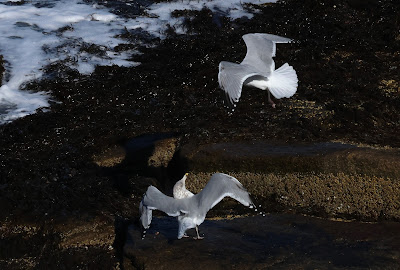An awakening is taking place on the shoreline at this time of year, as though the cooler days are stimulating active life. And that in a sense is literally true.
 |
Black Scoters flocking |
Coastal waters that had been relatively empty all summer are now repopulating with birds arriving from northern nesting grounds.
 |
| Surf Scoters |
Some of these will stay all winter in the open waters along Halibut Point, some will continue further south.
 |
| Common Eiders |
Massive numbers of these birds form migration flocks while diving for mollusks and seaweed along the rocky coast. The male Eiders are molting from drab summer plumage to the vivid patterns that will enliven frigid days ahead. Right now they are being joined by Harlequin Ducks as principal spectacles of the cold weather surf zone.
 |
| Northern Gannet |
 |
| Red-throated Loon |
Also arriving are deeper diving birds with various specialties in seeking fish, whether by plunging from the air as gannets do, or by swimming down with powerful legs like the loons, Razorbills, and Long-tailed Ducks.
 |
| Herring Gull |
Newborn fish are also on the move out of the nursery estuaries and rivers. When they are driven to the surface of the sea by larger predatory species, various birds try to seize them from above.
 |
| Great Black-backed Gull |
The larger gulls are not very adept at the agile maneuvers necessary for these opportunities.
 |
Cormorant and
Ring-billed Gull fishing,
|
 |
| Laughing Gulls |
The lighter gulls are more tern-like in their aerodynamic buoyancy.
 |
White-rumped Sandpiper |
Late-departing shorebirds occasionally make a stopover at Halibut Point on their way toward winter realms. This juvenile White-rumped Sandpiper was a surprising sight foraging in velvety algae at low tide, considering its origins in muddy habitat of the High Arctic tundra.
 |
White-rumped Sandpiper |
Birds of this species on their way to the furthest tip of South America make one of the world's longest migratory flights.
 |
| Canada Geese |
The wide open skies along the coast make fine viewing for fall's seasonal wonders.
* * *
A reader sent this interesting anecdote after
last week's essay.
"That photo of the female redstart reminds me of the time we were sailing off Gloucester. I was steering the sailboat with my hand on the wheel. A tired bird alit on the back of my hand. After watching it for a minute, I very carefully used my free hand to swat a fly in the cockpit. I picked up the dead fly and slowly placed it on my forearm. The tired bird hopped over, ate the fly, and departed. True story. One I’ll never forget."




























%20-%20seaside%20plantain.JPG)



